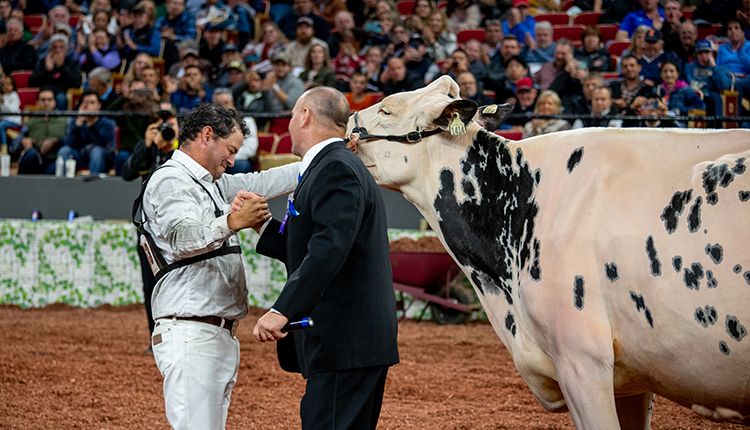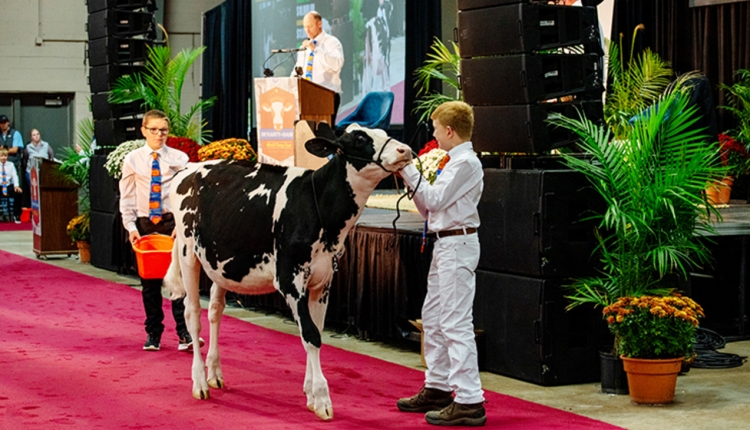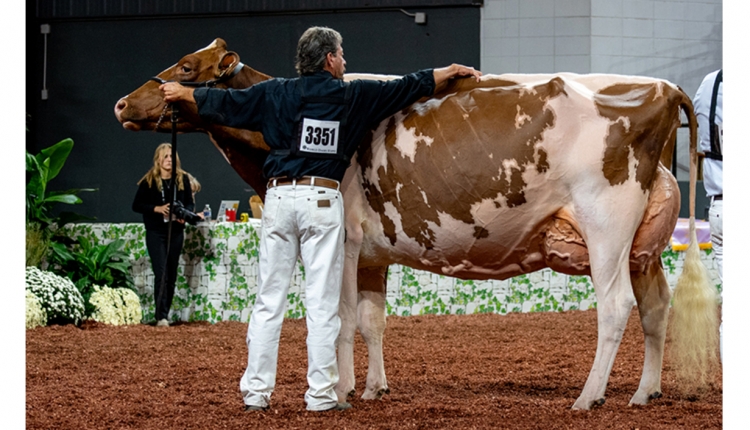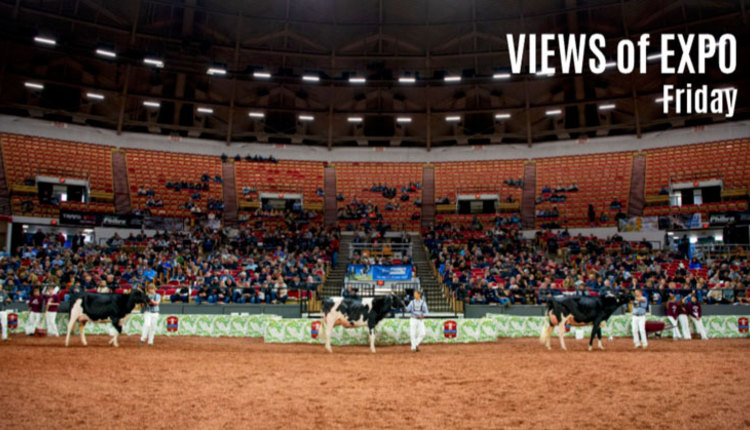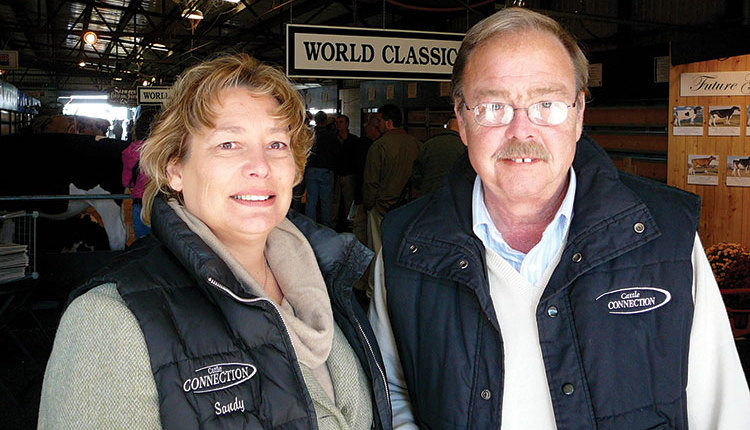
Perhaps the most innovative dairy cattle sales managers of their era, Tom and Sandy Morris have been managing the World Classic Sale since 1989. However, that’s only a portion of their story. Their World Dairy Expo involvement has spanned decades. Tom showed the winning 3-year-old, a homebred Holstein, in the Coliseum’s inaugural year; developed a leading dairy cattle publication; and shared his leadership talents on the Dairy Cattle Exhibitor Committee for 30 years, most recently chairing the committee for the past six years.
Tell us about growing up in Wisconsin’s Waukesha County, the epicenter for some of the greatest show herds in that era.
Tom: For many years, Waukesha was “Cow County USA” because of the tremendous multibreed influence and showring success. I grew up on my family’s Arwyn Farm about 4 miles from Pabst Farms and 6 miles from Braun’s Sunny Lea Farm. Crescent Beauty was in nearby Jefferson County, while Gray-View was down the road in Racine County. The area was a hotbed of the Holstein industry. It was those people who were really influential in starting a dream that became World Dairy Expo.
Sandy: I was pretty young when my family left Mayer Farms, 11 years old to be exact. It was a different era. My perspective was pretty narrow around the confines of Mayer Farms. Remember, I still attended a one-room school, and our church was one-quarter mile down the road. But there was no doubt that the area was a Holstein hotbed.
You were high school and college students when the efforts to create World Dairy Expo got rolling. What do you recall?
Tom: My memory goes before the creation of World Dairy Expo. I watched Allen Hetts, Howard Voegeli, Norm Magnussen, Gene Nelson, and other neighbors put together the first donation heifer sale to get a little seed money to start World Dairy Expo. In those early days, I had the privilege of working the show string with Hetts, Magnussen, and the Nelson family, so I was in over my head as a high schooler . . . but I loved every minute of it.
Sandy: As far as the beginnings of Expo, I went to the show as a senior in high school in 1971. However, I vividly recall how excited my dad was to go the first year in 1967. He was very pleased to have Expo start in Madison, Wis., and take over from the big league shows that he grew up attending at the National Dairy Cattle Congress in Waterloo, Iowa, and the International Dairy Show in Chicago, Ill. We, as children, weren’t able to go because we had to stay home and do chores.
At the first fundraiser sale for the World Food & Agricultural Exposition, among the 42 Holstein consignments in the all-breed sale that day were lot 37 from Arwyn Farms and lot 67 from Mayer Farms. Why did your families believe and more importantly donate to that initial fundraiser?
Tom: It was a dream. Waterloo was going down, and Chicago was about done. Sandy’s family always took big show strings. Our family usually took one or two Holsteins in the back of the boxcar with Pabst Farms. Everyone involved in the show scene in those days thought they were losing a way of life. That’s why everyone came together. Those four or so main founders were really serious and put the positive peer pressure on everybody to join in and bring this show to Madison.
Tom, having shown Arwyn Reflection Pammie to All-American 3-year-old honors in 1969, talk about those first shows at World Dairy Expo.
Tom: At the very first show in 1967, we showed in the Arena Building because Dane County was still building the Veterans Memorial Coliseum. With the Coliseum still under construction, we showed in the Arena Building again in 1968. I remember when Pammie won, it was 1969, and that was the first show in the Coliseum.
While the show had some financial struggles in the early days, once it turned around the show really took off. From that time period, not only did the cattle change, the whole perspective of World Dairy Expo evolved by becoming all dairy from one end to the other . . . both the trade show and the cow shows.
Tell us how your previous life experiences prepared your work in purebred dairy cattle sales.
Tom: Sandy and I have been through a lot of changes. At first, I spent 10 years in post-secondary education designing, developing, and teaching the first nine-month dairy herdsmanship program in the country. In fact, I took students down to World Dairy Expo on a two-day field trip each year.
While teaching, I also worked with Al Piper in the dairy cattle business, and we bought our farm. Then we started our own sale company, partnering with Jim Hoskens and eventually started the publishing division, and didn’t know where we were going next.
Taking a step back, both of us grew up on registered farms and showed Holsteins in 4-H, the Wisconsin Junior State Fair, and Black and White shows. What amazes me is there were four in my family, and I was the only one who got bitten by the cattle bug as the rest went off and got “real” jobs.
We’ve been on our farm for 40 years now. Our Deronda Holsteins featured a small, select, high-type herd and we enjoyed showing and merchandising. One of our biggest decisions, and we really fought with it, was dispersing the milking herd at Deronda. It just got to be too much, after starting these other divisions in our business. We both still think about it when we look at the barn.
That said, we were fortunate enough to have three complete dispersals in the 1980s, and all three of them were the highest averaging complete dispersals in America for their respective years. So, there are many good memories when we look at the barn, except when it’s 20°F below zero . . . then we think that barn looks good empty.
Sandy: All of our experiences are like chapters in a book and build upon one another. Each chapter helped us grow in each of them. Had we started the Cattle Connection publication without having had the life experiences growing up in the registered business or in the sales business, the publication would have been a whole different scenario and wouldn’t have worked as smoothly. It’s just like if a farm starts out with grade cows but then builds up to a bigger herd, or maybe into registered cattle, or even a different breed altogether . . . all of those past experiences help them be better.
While not directly connected with World Dairy Expo, one of your big breakthroughs in the sales business was co-managing the Century II Sale at the 1986 National Holstein Convention with Jim Hoskens. That sale grossed $1.287 million on 130 head. How did that sale set you up for the next stage of sales management and auctioneering?
Tom: It was very important for two kids, like Jim and I were at that time, to have the opportunity to bid that sale. Of course, we bid two years earlier and the rough part of it was that the Reagan administration had changed the tax laws between our sale bid (1984) and the actual convention sale (1986). The investors that fueled many sales were gone the year of our sale. It put an awful lot of pressure on us. However, it was a thrill having that sale. Since then, Sandy and I have managed eight other national convention sales, but probably none of them were as special as that one because we really broke into the business.
Sandy: When you asked, “How did that 1986 sale set us up?,” it demonstrated that we were able to work through issues in the evolving dairy economy, and we were able to have a good, successful convention sale. That set us up for more convention sales and bigger opportunities in other sales, too. For us, it was our first big hoopla.
The very next year you entered the sales scene at World Dairy Expo by hosting the Genetic Connection Sale. Those two sales (1987 and 1988) did not feature live animals but instead included embryos and contract flushes. Talk through those innovations.
Tom: Brad Rugg, who was World Dairy Expo general manager at that time, sat down with us and explained his desire to have a different kind of sale at Expo on Thursday night. He didn’t have specifics and was exploring ideas. So we spent a lot of time researching ideas and developed a plan. It became one of the first auctions that had no live cattle. There were videos on some of the lots, and contract flushes guaranteed six or eight embryos with the buyer’s choice of service sire.
Sandy: In that era, the Genetic Connection Sale was quite innovative because we didn’t have actual cattle on the grounds at World Dairy Expo . . . an event rooted in live cattle shows. That sale scenario we first innovated 30 years ago has come full circle, as a number of high genomic sales do not have live cattle but rather feature high-priced genetics.
In 1989, Tom and Sandy, you took over the management of the World Premier Holstein Sale and renamed it the World Classic. Those sales have become some of the highest averaging and most well-attended sales in the world. How do you keep these sales energized each year?
Tom: Jim and I had split our business partnership after the 1987 sale, and in 1988, Sandy and I did the Genetic Connection Sale. Then in 1989, the executive committee of World Dairy Expo invited us to a meeting and asked us if we would run the Friday night sale. We explained our goal would be to select and assemble a “limited offering of the world’s most sought-after Holstein genetics.” More than a tag line, it reflected our hopes for the World Classic and World Dairy Expo to become the “International Marketplace” over the years. More than 20 percent of buyers have been international. We told World Dairy Expo leadership that we would do the best we could each year to have one of the highest averaging sales of the breed. I think we pretty much stayed the course on those promises.
We’ve been able to do this because we’ve utilized the best people — sales force, selectors, fitters, staff — who are all leaders with wide-ranging contacts throughout the international dairy community who can get and get sold these elite genetics.
Tom, you have been a longtime member of World Dairy Expo’s Dairy Cattle Exhibitor Committee. How does this grassroots committee contribute and reshape World Dairy Expo?
Tom: I’ve been on the Dairy Cattle Exhibitor Committee for 30 years. It has changed over that time, but most of the issues on the cattle side go through that committee. The executive committee reviews and approves decisions; however, the committees are where the ideas come from and where they are talked about. It’s very grassroots.
As for a specific event, I didn’t think I would ever see the pavilions in my lifetime. But those buildings came about thanks to Wisconsin’s Department of Agriculture, Trade and Consumer Protection Secretary Ben Brancel, WDE President Mike Holschbach, and others. There were five of us on the building committee, and I sure learned a lot about building design, ventilation, and other related matters.
I also think the committee has led in innovating the health check-in process. We started with the premise that “We’re going to check you in before we tie you in the barns.” We were also going to wand the cattle and read RFID tags. We can identify issues immediately, and if there is a disease or health problem, cattle don’t enter the barns. I think it’s essential that Expo has to lead the way, and that’s why the new committees form. That’s been a really huge improvement.
World Dairy Expo has two main committees, the Commercial Exhibitor and the Dairy Cattle Exhibitor Committee. Those are the people who are really out in the front lines. It’s not somebody up in the top office reading reports. On those committees, everybody has really got World Dairy Expo in their heart. And there is a reason why it grew to be the most successful show in the world while a lot of other shows have had financial struggles.
What still needs to be done at World Dairy Expo?
Tom: We have to stay up with the industry because that’s what took Waterloo down. They didn’t keep up with the industry. You always have to be at the top of your game and be exhibitor friendly to both areas. We need to keep the show alive on both sides, the commercial and the dairy show because we have so many fewer dairymen out there.
Sandy: That grassroots structure of World Dairy Expo helps the show remain relevant. You have to be seeking thoughts and ideas for the future, not just from a seven-member executive committee. People have to go into the barns and into the booths and learn what works for them. Keep asking for input, and that will help keep Expo successful and relevant.
You have given back to youth, including establishing the Merle Howard Award for the top junior exhibitor at World Dairy Expo. Why do you give so generously to youth?
Tom: If you don’t have youth coming into the business, it’s game over. People were so very good to both of us; I guess we are repaying their generosity.
Think of all the kids who have won the Merle Howard Award as the top junior exhibitor since 2004. They have all come back every year and stood in the center of the ring as the new winner is announced on Saturday. These are the young people that Merle would be proud of, youth who are really involved in this industry. It’s not easy to pick them, but I think the committee has done an excellent job every year.
Sandy: You have to look to the future, and one way we can do that is by supporting youth organizations, youth groups, scholarships, and shows around the country. We must keep young people interested.

